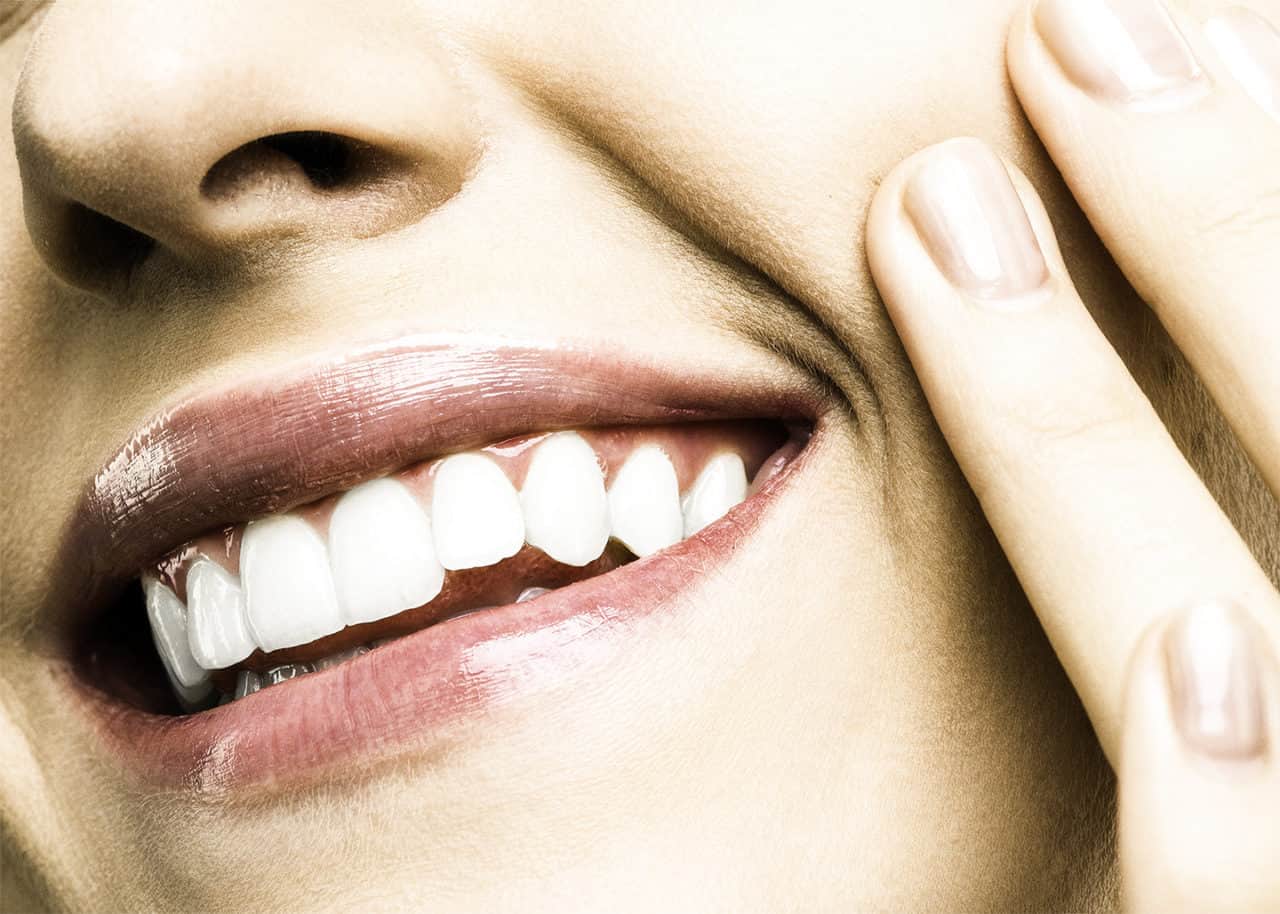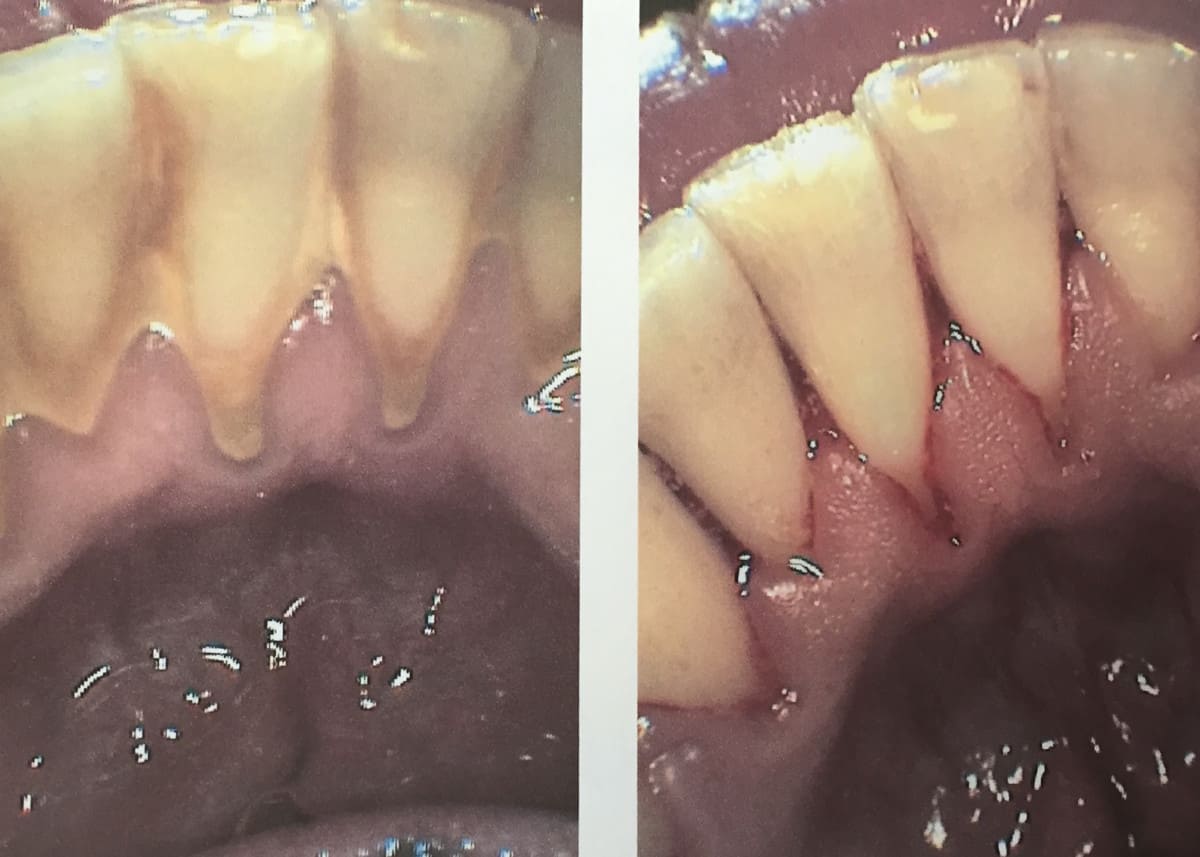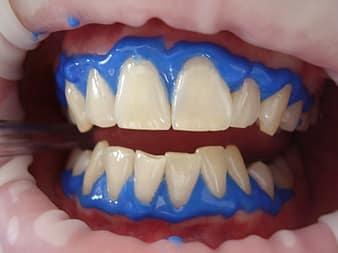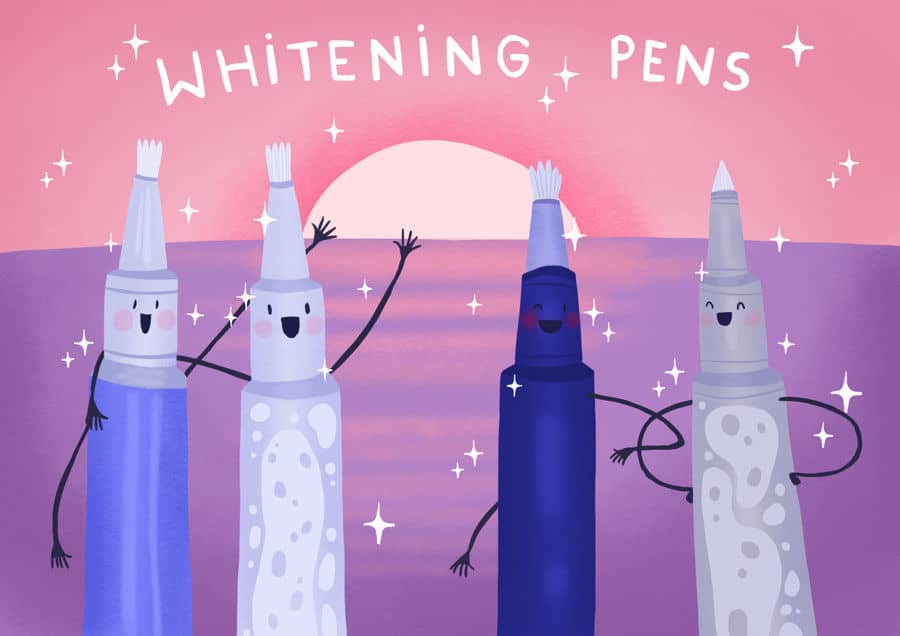
Having a beautiful bright white smile is what a lot of people want, including me. As a dental hygienist, I like to chat with my patients about using teeth whitening strips, how to use them, and how to get the best result possible. But how exactly do they work?
Teeth whitening strips work by using either carbamide peroxide or hydrogen peroxide. Contrary to popular belief, no bleach is used. The term bleaching comes from the act of whitening the teeth. The peroxide penetrates the tooth, allowing the active ingredient to break down the stain pigment.
Whitening teeth at home has never been so easy and accessible. However, to get the best results, a few things need to be followed. In this post, I go over how teeth whitening strips work, what you NEED to know before whitening, how to use them, and a few more tips and tricks that I give my patients in the dental chair.
How whitening strips whiten teeth
Whitening strips use an active ingredient, either carbamide or hydrogen peroxide. Carbamide peroxide is usually the more popular choice, as it breaks down into hydrogen peroxide and urea. The peroxide will actually change the colour of the teeth, and not just remove the surface stain to reveal a whiter tooth underneath (as abrasive whitening toothpastes do).
If the whitening strips you are looking to use (or are using) do not contain these ingredients, they simply will not work. There needs to be a chemical reaction for the stain to be removed/whitened.
If you are wondering about all the different teeth whitening products on the market, what works and what doesn’t, I put together a post you can find linked below. It covers the differences in over-the-counter products vs in-office whitening.
Read now: Teeth Whitening: Why It’s Worth Having Done at the Dentist
How does hydrogen peroxide whiten teeth?
When the strips adhere to the tooth, the peroxide will begin to dehydrate/penetrate the tooth surface, allowing the tooth to absorb the peroxide to break down the pigment in the tooth.
Once the hydrogen peroxide is absorbed into the teeth, it will oxidize and break apart the atoms. When the atoms break apart, it causes the molecules of the stain to split, making them fall apart. This action removes and “bleaches” the stain that is embedded in the tooth.
With whitening strips, the peroxide is on an adhesive strip that will stick to the teeth and deliver the product onto the teeth for a set amount of time.
There are different percentages of peroxide used in the strips, depending on what the consumer wants. But the higher the % of peroxide, the more effective the strips will be.
This study
shows that using whitening strips with 14% hydrogen peroxide penetrated deeper into the tooth, resulting in a superior result over a 6% hydrogen peroxide whitening strip.
But before deciding to go ahead and buy whitening strips, you must be aware of the risks, what the strips will not affect, and even the potential damage they can cause!
What whitening strips wont work on
Anything in your mouth that is fake and not actual real tooth structure will not whiten, and the peroxide can even start to degrade the fake tooth surface. Here is a list of things in the mouth that will not whiten;
- Fillings (both amalgam and composite)
- Crowns
- Bridges
- Braces
- Bonding
- Veneers
- Dentures
- Flippers
- Inlays, onlays, and overlays
It’s not just dental work that will not whiten, the build-up on the teeth (known as tartar/calculus) will not whiten either. The tartar/calculus is calcified bacteria that are strongly adhered to your teeth.
Tartar/calculus is porous and can absorb pigment when it slowly forms, and overtime being exposed to highly pigments food and drink, blood from bleeding gums, and pigments from smoking.

Tartar/calculus has a more yellow colour to it, and when it builds up, it can make the teeth appear more yellow. Often this is mistaken for stained teeth and cannot be removed through teeth whitening with whitening strips.
Before you use whitening strips – what you need to know.
Before you embark on the teeth whitening journey, you must make sure that your mouth is healthy. When you have gum disease (either gingivitis or periodontal disease), it can affect how effective the whitening strips are, and how much they irritate the gums.
When the gum tissue is inflamed from gingivitis, the gums puff up and become larger, and come down more on the tooth. This means that the gums are covering where the whitening material should be going (unless you have a lot of root exposure).
There is so much more to a white smile, and nothing is better than a healthy glowing smile.
How to use teeth whitening strips
First and foremost, please get a dental cleaning before whitening your teeth. It is really important to remove the tartar/calculus before whitening your teeth. Not only will the whitening not be as effective, I just don’t want you to be pouring your hard-earned money down the drain.
When you have a clear canvas of tooth surface to whiten, your results will be even more brilliant white and bright.
Before using whitening strips, you should be aware of the foods and drink that should be avoided when whitening the teeth. That info can be found a little farther along in this post and can have a huge impact on how successful the whitening can be!
Should you floss and brush before using teeth whitening strips?
When you are just about to put the whitening strip on your teeth, you want to make sure that you floss and brush before…. but DO NOT USE TOOTHPASTE!! There are ingredients in toothpaste that create a layer on the teeth that the peroxide will not penetrate as well.
It’s important to clear away any food particles and plaque from your teeth so the whitening solution can cover more surface area.
If there is plaque and food on the teeth, the whitening solution will not penetrate it and get to the tooth surface. This will reduce the results, and could also cause patchiness on the tooth as some sections will not whiten as much as other spots.
Ready to whiten!
After you understand all the pre-flight checks, as you could say, you can begin to use the whitening strips.
You will want to read the instructions that are included with the whitening strips as there are different wear times, and will have specific instructions to follow.
Make sure the teeth are dry: How I do it.
You will want to make sure that the surface of your teeth is as dry as possible. The whitening strip will adhere better to the tooth if it is drier.
You may find it difficult to hold the lip back, but I try to curl my upper lip under itself, and I try to hold the lip off the teeth as much as possible.
You can take a piece of paper towel to lightly dry the surface of the teeth that you are about to place the whitening strip on. You can even try and breathe in through your mouth, which may sound weird, but it works!
Placing the whitening strips on your teeth.
You will want to be very slow and precise with applying the strips onto the teeth. You want to make sure that you do not get them on the gum tissue.
A good rule of thumb for applying the whitening strips is to look where the gums come down the most on the teeth. Try and level off the whitening strips and apply them where the gums come down the most. It is also easier to apply it to the front teeth first and work your way back from there.

However, you should be mindful if you have root exposure. The roots are generally where people have more sensitivity since it is a different structure than the crown of the teeth. The crowns have a protective layer of enamel, like a helmet.
The root surfaces are more porous and more likely to cause sensitivity. The root surface is also more yellow, so you may want to whiten it, but shouldn’t.
How to prevent sensitivity from teeth whitening
Teeth whitening is often not a very comfortable thing to do, but, no pain no gain right? Wrong, most of the sensitivity from whitening your teeth can be prevented.
Below I linked to a post I wrote about tooth sensitivity and how to prevent it! I find that most people need to stop the process of whitening their teeth because it’s too painful, you want to make sure you are getting the most out of your treatment :).
Read Now: Teeth Whitening Zingers: How to Prevent or Stop Sensitivity
For about 2 weeks before you start whitening, you should start to use a sensitivity toothpaste that has potassium nitrate in it. The best one to get is the original Sensodyne. Click the link above to learn WHY original Sensodyne is the best to use.
Sensodyne is the top brand for sensitivity (they do not pay me to say that)! And make sure to just get the white paste, you don’t want to use any pigmented paste as the colour can be absorbed into the teeth.
The difference between whitening strips (brands)
I see all of these social media advertisements and social media influencers using different companies whitening strips and trust me by doing the research, most of them are a waste of money. Even trying to reach out to the companies to get an ingredient list is difficult.
Crest Whitestrips have an extensive amount of research and studies behind them, and their product just works.
Some brands claim to whiten with coconut oil, which frankly, will not whiten the teeth. Please don’t throw your money away by purchasing from a company that either doesn’t list their ingredients or does not contain peroxide. You can find the Crest Whitestrips ingredient list here .
.
The best whitening strips to use
The best teeth whitening strips on the market are Crest’s Whitestrips. And no they do not endorse this post, it is my honest opinion.
Crest Whitestrips are by far the best on the market. I have seen other brands on social media advertising, and after doing my research and digging deeper into the ingredients that are in them, the research to back it up, it is lacking.
You can find all my go-to teeth whitening resources, and you can find the Whitestrips that I use at home, and that I recommend to my patients here .
.
In office teeth whitening

In-office teeth whitening is the gold standard. You receive high-quality treatment from a trained dental professional, and every aspect of the entire procedure is controlled. With so many things that could go wrong, and fine details being overlooked with at-home treatments, paying a little extra for a dental professional’s skill and knowledge is worth it.
Even if you are thinking of using whitening strips, ask your dental professional for any other tidbits of information that they have.
I have put everything that I know in this post about my professional/personal thoughts and opinions, but your dental professional knows your mouth inside out. They can offer you personalized advice, that frankly, I cannot give you through the screen on which you are reading this.
In-office teeth whitening is not only a very personalized experience, but the materials they use can offer a much better result that will last longer than just using whitening strips.
The percentage of peroxide we use in the dental setting is much higher, and cannot be purchased over the counter. Having a higher percentage of peroxide will penetrate deeper into the teeth and give a better result that will last longer.
Teeth whitening toothpaste – dangerous!
Please avoid whitening toothpaste at all costs. Most whitening toothpastes have abrasives in them and will abrade away the top layer of the teeth off, exposing more white enamel underneath.
And unfortunately, enamel does not grow back of reform. Once it’s gone… it’s gone.
And when you have minimal enamel left, the yellow dentin underneath will begin to show through, making the teeth appear more yellow!
There are a couple of whitening toothpastes on the market that use peroxide in them, but again, it’s such a small amount that the teeth are not going to get drastically white!
What about teeth whitening pens? Do they work?

There are so many teeth whitening products on the market, and teeth whitening pens seem to be becoming more popular. I wrote a whole post all about teeth whitening pens, do they really work?
Read now: Hygienist Explains; Do Teeth Whitening Pens Actually Work?
How to maintain those pearly whites!
For my full guide on how to prevent stain on the teeth, click the link below. But I will touch on some of them in this post.
Read now: Snub Coffee Stains; Dental Hygienist’s Guide to White Teeth
Now that you have done the work to whiten your teeth, maintaining those pearly whites, is important. You don’t want your teeth to stain too quickly, as whitening too often can be both expensive and can start to damage the tooth surface over time.
Preventing stained teeth is much much cheaper than whitening! The following things are what I do to prevent stained teeth, and what I recommend to my patients.
Avoid pigments – food, drink, you name it! Anything that goes in your mouth that has a pigment can be absorbed into the teeth. But what about that wonderful glass of red wine or your morning coffee? Sometimes we just can’t get away from pigment, and most super healthy foods have lots of pigment, like spinach and blueberries!
Because we can’t just eat a beige diet (although I know a few people who may contest this), I always recommend that when consuming pigmented foods and drink, that you eat/drink them as quickly as possible, use a metal straw when applicable, and most importantly… DRINK WATER 🙂
After consuming pigmented food and drink, you should drink some water and gently swish it around your mouth. This rinses away a lot of the pigment that is on the teeth before it can really set in!
Another way to prevent stained teeth, the famous f word – FLOSS!
I know us dental folk always sound like a broken record saying that you should floss every day, but it really does a lot more than people realize.
I hope you have a great day, and you are well on the road to a healthy and white smile!
Holly 🙂


